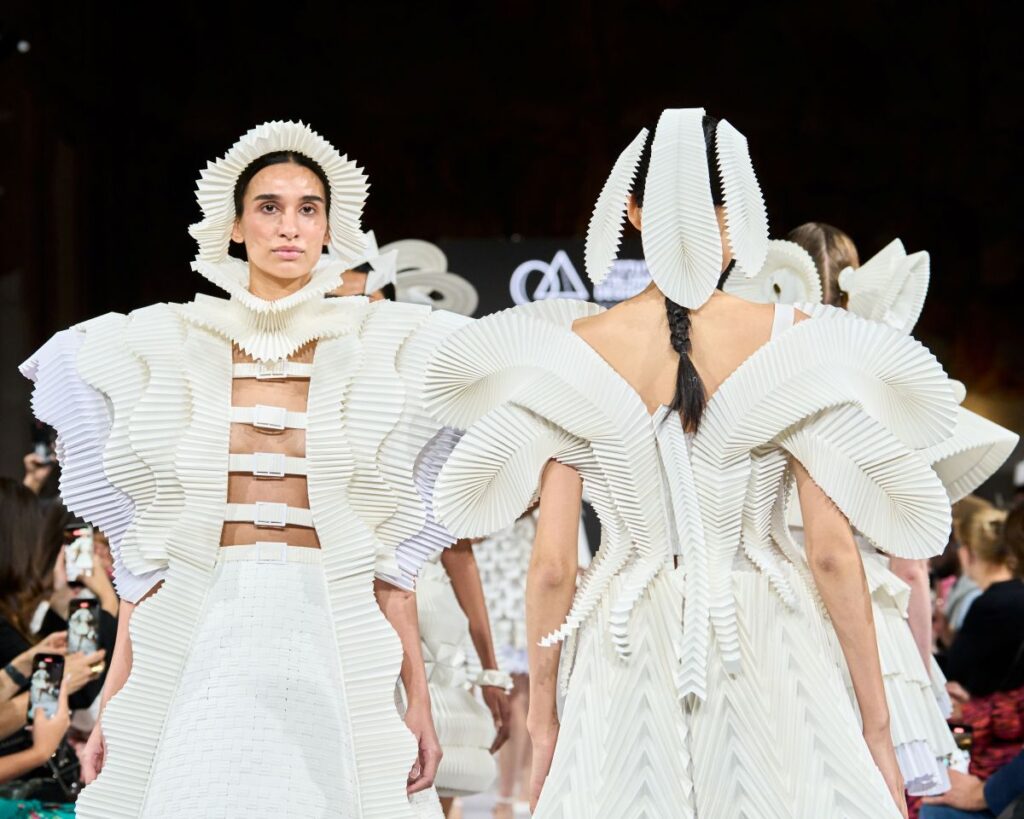Amidst the buzz of last month’s Milan Fashion Week, local artisan James Dimech made his mark with an eight-piece paper-crafted collection. Known for his transformative paper sculptures, James Dimech built his reputation for turning paper, a historic yet versatile material, into something unexpectedly bold. Dimech bridges craftsmanship, sustainability, fashion, and contemporary art. His practice moves fluidly between sculpture, installation, and wearable art.
The collection, titled Paper Crazy, featured eight garments, six of which were created in collaboration with students of the Istituto Italiano di Design in Perugia. Inspired by the traditional organ pleat, the works pushed its boundaries, exploring the expressive power of folds and form. The remaining two looks epitomised both Dimech’s and his brand’s commitment to sustainability and innovation.
With crisp folds and organic layering, the pieces echoed origami and classical drapery while leaning into futuristic silhouettes. By stripping away colour, the designs celebrated the purity of paper, allowing light and shadow to carve out striking contrasts and sculptural forms. The result was less fashion in the conventional sense and more wearable contemporary art; avant-garde, meticulously hand-crafted, perfected, therefore, essentially luxurious.
‘I’ve always loved folding paper since childhood, and during my studies I used to craft architectural paper models’, Dimech explained. ‘Over time, I combined that passion with my love for fashion, and that’s how my journey into paper sculptures began.’
This Maltese contemporary artist seeks to explore the relationship between geometrical sculpture and organic human form through three-dimensional experimentation. His works spark a dialogue between form and body, man and man-made.
The collection presented avant-garde pieces with futuristic, almost surreal silhouettes. In truth, this is wearable contemporary art – meticulously hand-crafted and perfected. By stripping away colour, the designs highlighted the purity of paper, allowing light and shadow carve out dramatic contrasts and sculptural depth.
‘Paper felt like the natural medium, because it’s versatile, immediate, and allows me to transform something humble into something extraordinary.’
Once dismissed as flimsy and temporary, paper was here reclaimed as a material of strength, elegance, and bold experimentation. The look struck a delicate striking a balance between sturdy and fragile, refined yet daring, proving that fashion can be both ephemeral and monumental at once.
Paper, long dismissed as fragile or temporary, is now being reclaimed by many contemporary artists for its versatility, immediacy, and symbolic weight. The looks, at once sturdy and delicate, elegant and refined, read less as garments and more as sculptural experiments, challenging assumptions of permanence, wearability, and value.
When asked about artistic influences, Dimech explained, ‘No one in particular inspires me directly. Instead, I draw inspiration from everything around me.’ He said, ‘I like to observe the world from different angles and let my creativity reinterpret what I see.’
‘It’s less about following existing artists or designers, and more about cultivating a personal way of seeing and translating those impressions into my work.’ This approach echoes a long-standing theme in modern and contemporary art: that creativity resonates most powerfully when it is provocative and forward-looking.
The pieces were presented as full looks, with each paper garment inspired by modern women’s clothing and paired with a headpiece. The collection were crafted from three key sustainable materials: Cork Paper, Kraft-Tex, and Milk Tissue Paper.
Each material aligns with the brand’s eco-conscious philosophy: Cork Paper is lightweight, biodegradable and sourced from renewable bark; Kraft-Tex is vegan flexible material made from natural cellulose and uniquely ages like leather; and Milk Tissue Paper derived from recycled fibres, introduces transparency and softness, adding a delicate counterbalance to the collection’s bold forms.
For six of the eight looks, Dimech and his team of students and pushed the formal boundaries of the organ pleat. often described as architecture in fabric, the organ pleats, bold, repetitive folds create drama and rhythm, lending garments both movement and sculptural presence.
‘The organ pleat became central because it was something I explored with my fashion students at the Istituto Italiano Design in Perugia over the past year.’ The designer explained, ‘I wanted to show them how a simple pleat could be applied and modified to achieve endless variations. This piece’s versatility makes it fascinating, because it carries a sense of tradition, yet it offers limitless opportunities for reinterpretation.’ The most fragile material can, paradoxically, embody the greatest strength. Dimech’s work is a testament to the enduring impact of hand-craft, and the remarkable skill of local artisans. His collection stands as a vision of forward-looking fashion – innovative in silhouette and eco-conscious materials.
